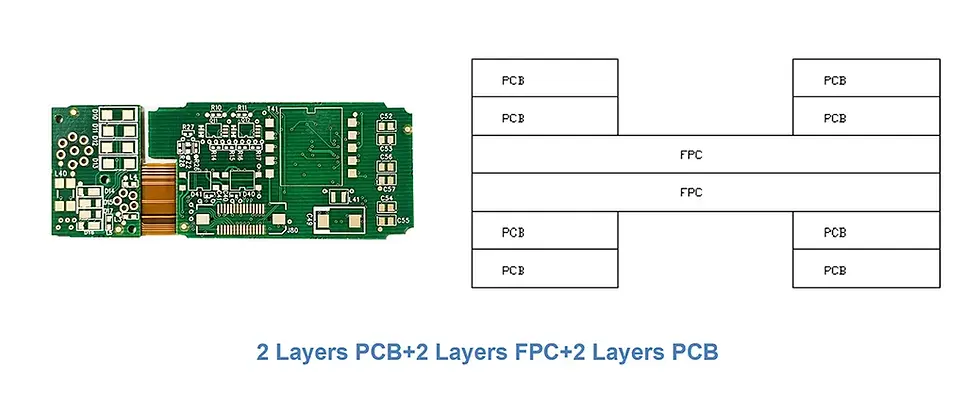Rigid Flex Circuit Board: Comprehensive Guide
- Flex Plus Tech team

- Jul 7
- 3 min read
What is a Rigid Flex Circuit Board?
A rigid flex circuit board is a special type of printed circuit board (PCB) that combines both hard (rigid) and bendable (flexible) parts into one board. It gives the strong support of a regular board while also being able to bend, making it useful in many kinds of electronic products.
This type of board usually has several bendable layers joined with one or more hard sections. This design lets the board fold or bend when needed, which helps avoid using extra connectors and cables. That makes it easier to put together and more reliable. Flex Plus, a professional manufacturer for rigid-flex circuit boards and flex PCB, makes these advanced boards for devices that need strong and flexible circuits.
How Rigid Flex Circuit Boards Are Made?
Making a rigid flex circuit takes more steps than making a normal PCB because it uses both stiff and flexible materials. Here's a simple breakdown of the process:
Material Prep: Uses FR4 for the stiff parts and polyimide for the bendable parts.
Circuit Patterning: Circuit designs are printed and shaped onto copper.
Layer Joining: All layers are pressed together with heat.
Drilling & Coating: Holes are made and coated to connect layers.
Outer Layers: The outside layers are also printed.
Protection Coating: Covers are added to stop damage and rust.
Final Touches & Testing: A protective surface is added, and the board is tested for function.
Flex Plus follows strict checks at every step to make sure the circuit boards work well and last long.
Benefits of a Rigid Flex Circuit Board
Here’s why using rigid flex PCB board is a smart choice:
Saves Space: Great for small devices, because it fits into tight spaces.
Strong & Durable: Fewer connections means less chance of parts breaking.
Better Signals: Shorter paths make signals travel better.
Lightweight: No need for heavy connectors or wires.
Saves Money Over Time: Fewer parts and faster assembly cut costs.
Flex Plus uses these strengths to help customers build smaller and better products.
When Should You Use a Rigid Flex Circuit Board?
You don’t always need a rigid flex circuit board, but it’s best in cases like:
Tight Spaces: Used in wearables, smart glasses, small medical devices, and aircraft.
Moving Parts: Needed when the board must bend or fold.
High Dependability: Best for important systems like defense or airplanes.
Multiple Boards: Reduces how many connectors are needed.
Flex Plus helps clients decide when a rigid-flex circuit board is the right choice, balancing performance and cost.
Key Features of Rigid Flex Cicruit Boards
Some important things to know about these boards:
Many Layers: Can mix stiff and bendable parts in many layers.
Handles Heat Well: Works in a wide range of temperatures.
Flexible Bending: This can be made to bend a specific amount.
Signal Protection: Helps block outside interference.
Strong Connections: Fewer loose parts means fewer failures.
Flex Plus also helps customers design the right PCB for their needs.







Rigid Flex Circuit Board Construction
A rigid-flex circuit board includes flexible parts inside strong board areas:
Rigid Parts: Made of FR4 with copper lines for support.
Flexible Parts: Made of thin plastic (polyimide) and copper for flexibility.
Plated Holes: Let electricity move between layers.
Protective Layers: Keep the flexible parts safe from wear and tear.
Extra Support (Stiffeners): Sometimes added for more strength.
Flex Plus FPC uses trusted materials and builds in certified factories to make sure every board is high-quality.
Where Rigid Flex Circuit Boards Are Used?
These rigid flex PCBs are used in many modern industries:
Aerospace & Defense: Planes, satellites, and strong communication gear.
Medical Devices: Pacemakers, scanners, and portable tools.
Electronics: Folding phones, cameras, laptops.
Cars: Navigation, entertainment, and safety systems.
Factories: Robots, sensors, and control machines.
Flex Plus provides rigid flex PCB for well-known brands around the world.
Design Challenges
Even though they’re great, designing these boards has some challenges:
Bending Limits: Too much bending can damage the board.
Choosing Materials: Must be both strong and flexible.
Managing Cost: Costs more at first but saves money later.
Heat Issues: Different materials react to heat differently.
Design Rules: Must follow certain rules to work properly.
With more small and smart electronics being made today, rigid flex circuit boards are becoming more popular. Trust Flex Plus, your reliable flex PCB and rigid-flex PCB manufacturer, to deliver strong and creative printed circuit board solutions built for your needs.




Comments